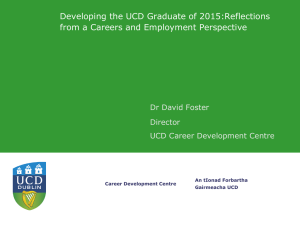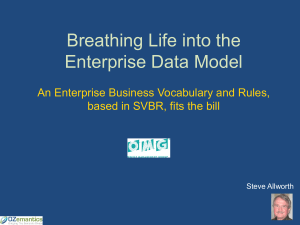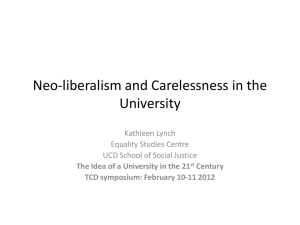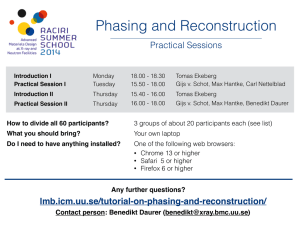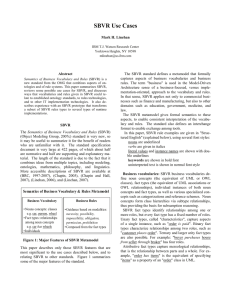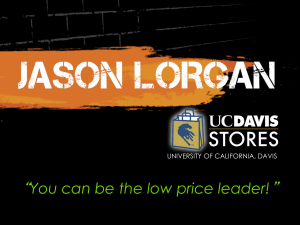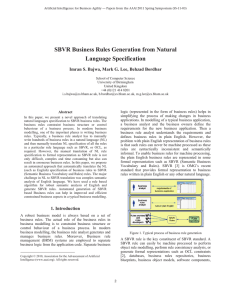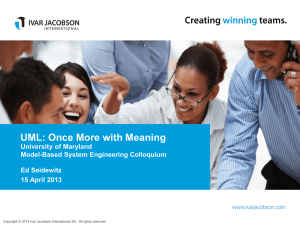tomas_skersys
advertisement
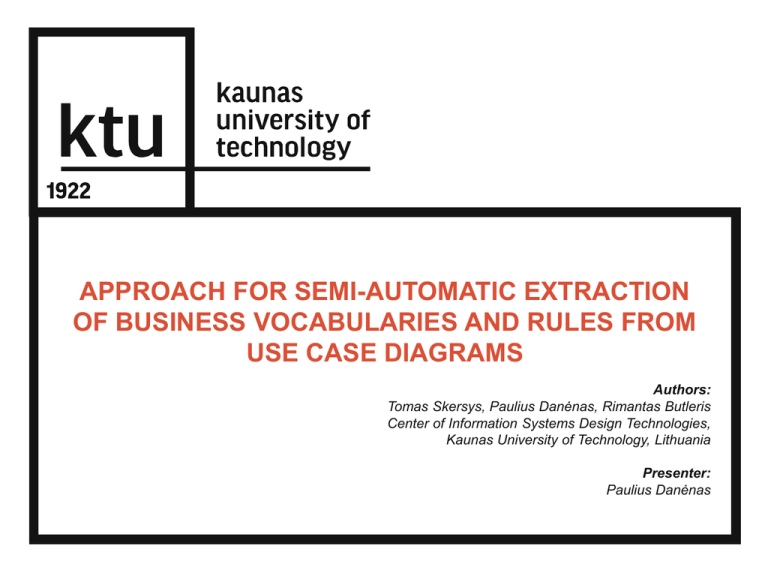
APPROACH FOR SEMI-AUTOMATIC EXTRACTION
OF BUSINESS VOCABULARIES AND RULES FROM
USE CASE DIAGRAMS
Authors:
Tomas Skersys, Paulius Danėnas, Rimantas Butleris
Center of Information Systems Design Technologies,
Kaunas University of Technology, Lithuania
Presenter:
Paulius Danėnas
Tomas Skersys, Paulius Danėnas, Rimantas
Butleris
OUTLINE OF THE PRESENTATION
• Research problem
• Very short introduction of techniques used in
research
• Description of proposed approach
• Experimental results
• Conclusions
2
Tomas Skersys, Paulius Danėnas, Rimantas
Butleris
3
VEPSEM PROJECT
• Stands for „Integration of Business Processes and
Business Rules on the Base of Business Semantics“
• Is run at Kaunas University of Technology, Center of
Information Systems Design Technologies
• The main goal is to integrate OMG standards
BPMN, SBVR and UML into one visual modeling
approach
• Extraction of SBVR specifications is one of the goals
of this project
Tomas Skersys, Paulius Danėnas, Rimantas
Butleris
4
PROBLEM OF THE RESEARCH
• Use Case diagrams are key tools for requirement
elicitation
• Extraction of business vocabulary and business
rules enables reuse of the knowledge represented in
these diagrams
• Synchronization with graphical requirement models,
enhanced efficiency and quality of corresponding
UML UC diagrams, reduced ambiguity and
eliminated duplicates, etc.
Tomas Skersys, Paulius Danėnas, Rimantas
Butleris
5
RELEVANT RESEARCH
• Currently, most of related work deals with transformation of UML class
diagrams to SBVR specifications and vice versa:
• SBVR BV & BR UML Class Diagram (SBVR specification,
Nemuraite et al., 2010, Bonais et al., 2012, Afreen et al)
• UML Class Diagram SBVR BV & BR (Cabot et al., 2010)
• SBVR BV & BR UML Use Case Diagram (Thakore, Upadhyay,
2012):
• Core concepts only – actors, associations and use cases;
• Does not cover full UCD specification
• NLP pattern based approaches to transform textual specifications to
UML diagrams
Tomas Skersys, Paulius Danėnas, Rimantas
Butleris
6
UML USE CASE DIAGRAMS
• Main tool for modeling
requirements
• Actors, use cases,
relationships
• More advanced concepts:
•
•
•
include, extend relationships
boundaries
generalizations
Tomas Skersys, Paulius Danėnas, Rimantas
Butleris
SBVR MAIN CONCEPTS
• SBVR stands for Semantics of Business Vocabulary and Business
Rules
• a novel standard enabling one to express business knowledge using
controlled natural language, which would be unambiguous and
understandable to business and IT people and also interpretable by
computers
• Version 1.0 released in 2008, current version is 1.2
• Main concepts :
•
•
•
General concept, a specialization of noun concept which classifies things
on the basis of their common properties ;
Verb concept denotes some type of relationship between two or more
noun concepts or a characteristic of the noun concept. Following the
definition, verb concepts are defined using the existing noun concepts,
which have been already defined in BV;
Business rule, a rule that is under business jurisdiction
7
Tomas Skersys, Paulius Danėnas, Rimantas
Butleris
8
SBVR FORMATING GUIDELINES
‘term’ formatting is used to represent general concepts (object types)
and roles, e.g. ‘sales clerk’. Best practices require that general
concepts and roles are defined in singular form using lower case
letters.
‘Name’ formatting represents individual concepts that usually are
proper nouns and represents names, towns, countries, companies,
etc. (e.g. ‘EURIS’, ‘Lithuania’). The first letter is usually capitalized.
‘verb’ formatting designates a verb, a preposition, or a combination of
these two. Verbs are used in singular active or passive forms as
synonymous forms (e.g., customer makes car booking,
synonymously car booking is made by customer);
‘keyword’ font represents linguistic symbols that are used to construct
statements and definitions, such as if, It is obligatory that, greater
than, that and etc.
Tomas Skersys, Paulius Danėnas, Rimantas
Butleris
9
LEVEL OF AUTOMATION
• manual M2M transformation – performed exclusively by the user;
• semi-automatic M2M transformation – partial user interaction, specific
parts transformed automatically
• automatic - without any user involvement; implemented as hardcoded applications or by using dedicated transformation languages
Tomas Skersys, Paulius Danėnas, Rimantas
Butleris
10
MAPPING MATRIX NOTATION
•
•
•
“A{i}” implies that a corresponding SBVR general concept, verb concept or rule
can be automatically identified and extracted from one or more UCD elements;
“M{i}” implies manual (semi-automatic) identification and extraction of a
corresponding SBVR general concept, verb concept or rule from one or more
UCD elements;
Each UCD concept is supplied with unique index “i” (see the first column in the
matrix). Then, a set of indexes next to the particular mapping A{i} or M{i} specify,
which UCD concepts are used to form a corresponding SBVR concept or rule.
•
•
E.g., A1,2,3 means that in our UCD BV&R approach each association (:
Association) in a given UCD will be a subject for automatic extraction of a SBVR
verb concept
additional indexes i = 1 and i = 2 indicate that each instance of this extraction also
involves certain UCD actor (Actor) and use case (UseCase) connected to each other
via that particular association.
Tomas Skersys, Paulius Danėnas, Rimantas
Butleris
11
M2M MAPPING MATRIX
UML UCD (source)
Index
UCD concept
SBVR BV&R (target)
General
Concept
Verb
Concept
Business
Rule
1
Actor
A1
-
-
2
Use Case
M2
-
-
3
Association
-
A1,2,3
-
4
Association Condition
M4
M4
M1,2,3,4,10
5
Include
-
-
A1,2,3,5,10
6
Extend
-
-
A1,2,3,6,10
7
Extension Point
M7
M7
M1,2,3,7,10
8
Generalization (between actors)
-
A1,8
-
9
Generalization (between use cases)
-
-
-
10
Boundary
A10
-
-
11
Comment
M11
M11
M11
Tomas Skersys, Paulius Danėnas, Rimantas
Butleris
12
BEST PRACTICES FOR MODELING UCD
•
•
•
•
•
Actors are represented as noun phreases
Only associations between Actor and UseCase are allowed – associations
between two UseCase elements and two Actor elements are also possible, but
discouraged to use;
UseCase names start with a verb and are followed by noun. It is possible that
this noun has adjectives or is related to other nouns using composition (“of a”)
or other relationships, although best practices advocate short use case names
conforming to pattern <verb><subject> (e.g., Create Rental Contract);
Extension point is considered and defined as a boolean condition which
defines destination point where functionality of an extending use case can be
inserted into the base use case
Association cardinality in UCD is generally not considered as a best practice; it
is not considered in this work.
Tomas Skersys, Paulius Danėnas, Rimantas
Butleris
13
TRANSFORMATION RULES
The following formal syntax is introduced to define rules and examples of their
application:
transformSourceModel, {P1, …, Pj})
•
•
•
•
𝐴|𝐴∗|𝑀
TargetConcept
M represents a source model for the transformation
{P1, …, Pj} is a set of parameters representing concepts of the source model, required for
the transform of TC presenting a concept of a target model ;
if any kind of relationship Pi is passed as a parameter, then it is specified as a predicate
Pi(Pn, Pm), where Pn and Pm are two concepts bound to each other with Pi
• e.g. Generalization(use_case1, use_case2) means that Generalization relationship is
defined in UCD between use_case1 and use_case2).
“Curly brackets” notation “{}” means that a set of particular concepts or particular type is
used as input or obtained as output.
• A – automatic transformation performed by the transformation tool using certain “A”
mappings in the mapping matrix
• M - indicates that a user interaction is necessary in order to realize certain “M”
mapping from the mapping matrix
Tomas Skersys, Paulius Danėnas, Rimantas
Butleris
14
EXAMPLES OF TRANSFORMATION RULES AND THEIR APPLICATIONS
•
Automatic extraction of a candidate general concept from UCD concept Actor:
transform(UCD, actor: Actor)
𝐴
general_concept: GeneralConcept,
𝐴
e.g.: transform(UCD_1, “Rental manager”) ‘rental_manager’
• Manual extraction of a candidate general concept from UCD concept UseCase:
transform(UCD, use_case: UseCase)
𝑀
general_concept: GeneralConcept,
𝑀
e.g.: transform(UCD_1, “Create rental contract”) ‘rental contract’
• Automatic extraction of a candidate verb concept from Generalization relationship relating
two Actors in a given UCD:
𝐴
transform(UCD, actor1: Actor, actor2: Actor, generalization(actor1, actor2): Generalization)
verb_concept: VerbConcept , e.g.:
transform(UCD_1, “Rental manager”, “Rental manager’s assistan”, generalization(“Rental
manager”,
“Rental
manager’s
rental_manager_assistan’.
assistan”))
𝐴
‘rental_manager
generalizes
Tomas Skersys, Paulius Danėnas, Rimantas
Butleris
15
EXAMPLES OF TRANSFORMATION RULES AND THEIR APPLICATIONS
•
Automatic extraction of a candidate verb concept from a triplet of UCM concepts Actor,
UseCase and Association(Actor, UseCase):
transform (UCD, actor: Actor, usecase: UseCase, association (actor, usecase): Association)
𝐴
verb_concept: VerbConcept , e.g.:
transform(UCD_1, “Rental manager”, “Create rental contract”, generalization(“Rental
manager”, “Create rental contract”))
•
𝐴
‘rental_manager creates rental_contract’.
Automatic extraction of a candidate business rule from Include relationship relating two
UseCases in a given UCD:
transform(UCD, usecase1: UseCase, usecase2: UseCase, include(usecase1, usecase2):
𝐴
Include) businessrule: BusinessRule , e.g.:
transform(UCD_1, “Create rental contract”, “Manage rental insurance”, include(“Create
rental contract”,
“Manage rental insurance”))
rental_manager_assistant manages rental_contract
rental_contract’.
𝐴
‘It is obligatory that
if rental_manager creates
Tomas Skersys, Paulius Danėnas, Rimantas
Butleris
BASIC ALGORITHM OF THE SEMI-AUTOMATED UCD BV&BR
EXTRACTION APPROACH
16
Tomas Skersys, Paulius Danėnas, Rimantas
Butleris
PROTOTYPE IMPLEMENTATION
• CASE tool MagicDraw UML :
•
•
•
full support for the newest official versions of UML, BPMN and other
modeling standards; SBVR support is under development.
DSL technology and profile development capabilities;
Open Java API enables development of extensions (plug-ins) for
MagicDraw UML.
• BV&BR extraction tool working as a plug-in of the MagicDraw UML
• SBVR editor VeTIS
•
•
a tool developed by the Department of Information Systems, Kaunas
University of Technology, Lithuania.
supports the development and syntactic validation of SBVR BV&BR.
17
Tomas Skersys, Paulius Danėnas, Rimantas
Butleris
IMPLEMENTATION (INCLUDING PLANNED FEATURES)
18
Tomas Skersys, Paulius Danėnas, Rimantas
Butleris
PROTOTYPE IMPLEMENTATION DIALOG
19
Tomas Skersys, Paulius Danėnas, Rimantas
Butleris
SBVR MODEL (VETIS OUTPUT)
20
Tomas Skersys, Paulius Danėnas, Rimantas
Butleris
21
SBVR MODEL (MAGICDRAW UML FACT DIAGRAM)
Tomas Skersys, Paulius Danėnas, Rimantas
Butleris
22
FUTURE PROTOTYPE ENHANCEMENTS
• Extensions to support other UML diagrams and
BPMN BPD
• UML class diagrams and statechart diagrams are
of particular interest to VEPSEM
• BPMN BPD diagrams are also researched
• Advanced NLP-based processing
• Further improvements
Tomas Skersys, Paulius Danėnas, Rimantas
Butleris
23
EXPERIMENTAL EVALUATION RESULTS
•
•
•
•
•
Extraction from properly formed UCD resulted in uncomplicated extraction
process
UCD with inconsistent naming schemes provided higher rate of errors in the
results of low-experienced SBVR users; experienced SBVR users dealt with
naming inconsistencies fluently.
Low-experienced SBVR users struggled while extracting valid candidate
business rules from text rumblings.
During the BV&R extraction process users detected invalid uses of UML
syntax and bad practices in the given diagrams. This proved our presumptions
that the quality of use case diagrams can also be improved during the
extraction process or after it.
Comparison of task execution times showed that it could take almost twice as
much time to complete the task with unsound source diagrams compared to
the time needed to extract BV&R from the sound ones.
Tomas Skersys, Paulius Danėnas, Rimantas
Butleris
24
CONCLUSIONS
• Diagrams might be might be complemented with natural language-like
specifications, which can be either semantically identical to graphical
models or convey additional information.
• BV& BR specifications should not be necessarily developed from
scratch – automated extraction tools may help to extract them from
existing specifications
• Our research confirmed that SBVR BV&BR can indeed be extracted
from UML use case diagrams
• We propose formal description ansd mappings and rules for extraction
as well as prototype implementation
• The experiments concluded that it enabled faster development of
well-structured, formalized business vocabularies and rules
• The proposed approach can be the basis for similar processing of
other UML diagrams as well; it is still under research
Tomas Skersys, Paulius Danėnas, Rimantas
Butleris
THANK YOU FOR LISTENING
QUESTIONS???
25
